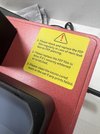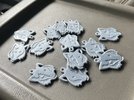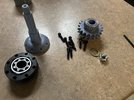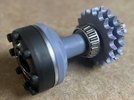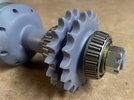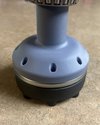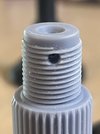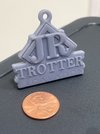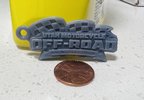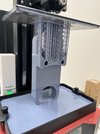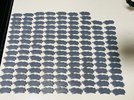For me the draw of resin is doing small features that a filament printer can’t do, and surface finishes that in my opinion, come close to near-injection-molded quality.
In size comparison; my filament printer can handle prints much larger than my resin printer.
(Filament print volume in my case is 15.7”x15.7”x17.7”, resin print volume is 8.6”x4.8”x9.8”)
Where a large amount of my prints are full-scale mechanical prototypes, the resin printer is not going to be able to print many of them (at least not in one piece)
I haven’t had it long enough to really give much of an opinion pro/con, but so far, 👍🏽
A neat thing about resin printers is where they print one whole layer at a time, versus one strand of filament at a time, is if you want multiples of an item printed, you can nest as many as you can fit on the build-plate, and it’s the same print time to print all of them at once, as it would be to print just one.
Not the same with filament of course, if you print two of an item it’s pretty much twice the amount of time as printing one.
One drawback that I don’t know if it’s really a drawback or not yet is there’s less choices for types of resin.
You pretty much have “standard” resin and “ABS like” which all I forsee myself ever printing is ABS-like as it’s stronger than standard. Less detail quality, but stronger. I have no idea yet on physical mechanical properties of the resins, like if it can withstand the heat of being inside a hot car in the summer, how brittle it is, UV resistance, how it reacts in the cold etc.
Colors are less plentiful too. You also need to block out all UV rays in the room you’re resin printing in too, so rooms with no windows are ideal.
______
As far as cost goes, resin printers are just a lot more mechanically simple.
Resin printers have one moving part; the Z-axis. And a UV light.
Filament printers have 3 axis and two heating elements. (Bed and nozzle)
Resin per kilogram is more expensive than many filaments per kilogram, so prints themselves could be more expensive.
Consumables comparison is nozzles for a filament printer, and FEP sheets for a resin printer. (The bottom of the resin holding tank/vat is a clear plastic sheet, so that the UV light can pass through) and apparently if they get damaged/broken/cracked then it can get messy and or ruin the piece that protects to UV light, so it’s recommended to replace the FEP sheet anytime it shows any sign of damage. I don’t know yet how often that is.
View attachment 172157
If you have a piece of cured plastic resin that’s hiding in your resin tank, like a piece that came off from a failed print or something, and you go to start your next print, your print bed could try to shove that piece of plastic through your resin vat, which would be catastrophic and cause extensive damage. So make sure your resin has no pieces in it before starting a print.
Resin printers also need some post-processing, including washing excess resin off your prints after removing them from the print bed. The resin I am using, and most resins, wash with isopropyl alcohol. The guy I bought the printer from told me “as close to pure as you can, with 97% being a minimum” so you have to keep a big jug of isopropyl alcohol around too to swish the parts around in. I bought a big plastic rectangular pitcher/storage thing.
They do make water-washable resins.
Prints can also need further curing post-processing, which means shining UV light on them. They make secondary units that do this, or there are homemade units too, (what I am doing) and like for today I took that sprocket gear with me today to work and just set it on the dash of the truck and let the sun rays hit it.

